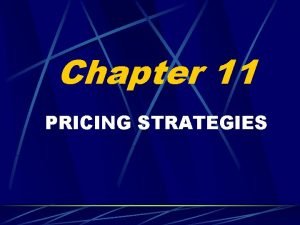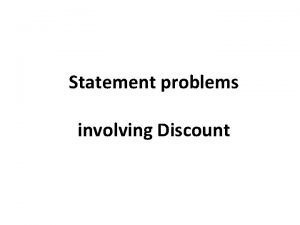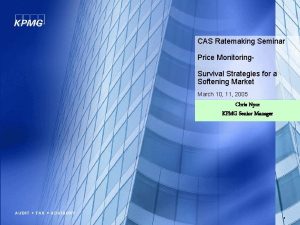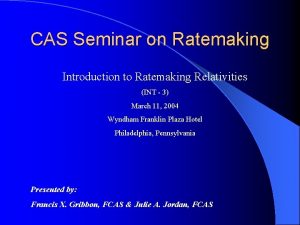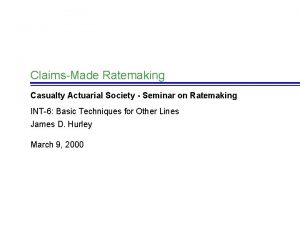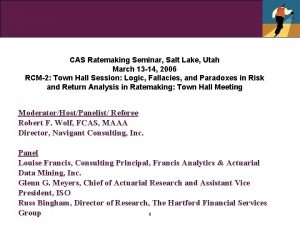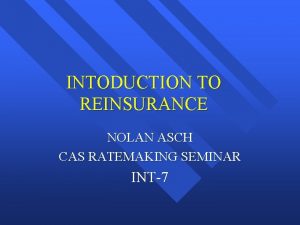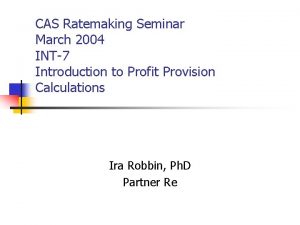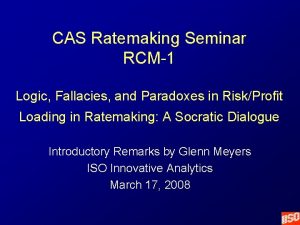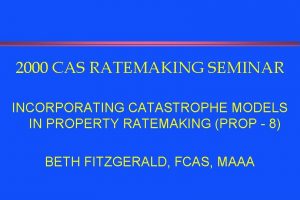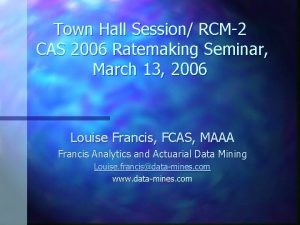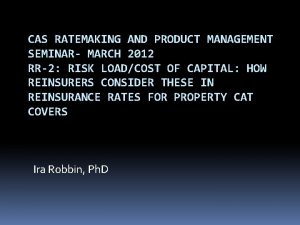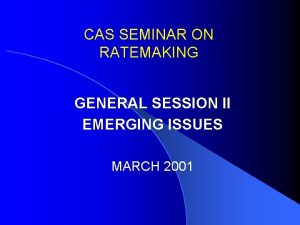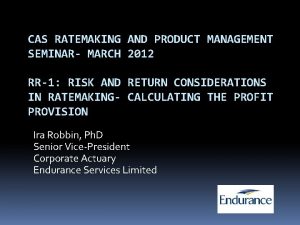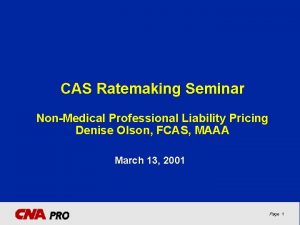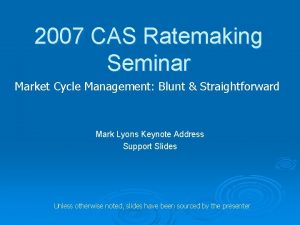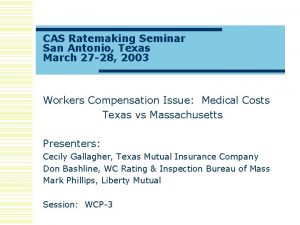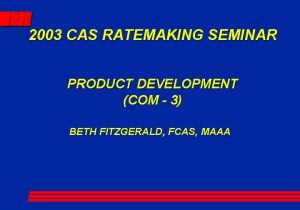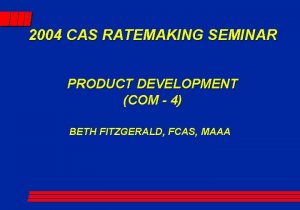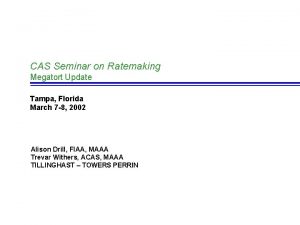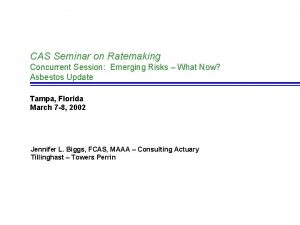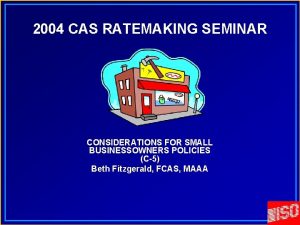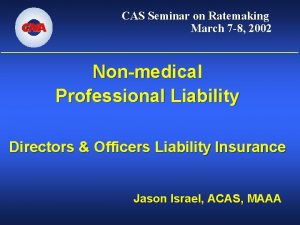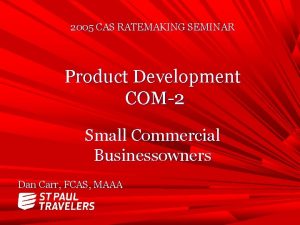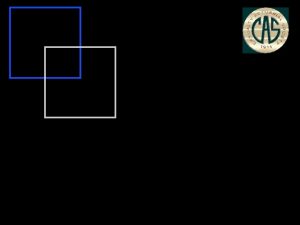CAS Ratemaking Seminar Price Monitoring Survival Strategies for



























- Slides: 27

CAS Ratemaking Seminar Price Monitoring Survival Strategies for a Softening Market March 13, 14, 2006 Chris Nyce Senior Manager KPMG LLP Brian Hughes Senior Vice President Arch Insurance Group 0

Disclaimer • The views expressed in this presentation are those of the speakers; and • They are not necessarily the views of the CAS, KPMG, Arch Insurance or any other sponsor of this seminar; • Anyone who says otherwise is not only wrong, but is itching for a fight. 1

Contents for the Presentation Introductions Why is price monitoring critical (and failures of the past) Chris Nyce Interactions between manual rates and prices charged Automating approaches: Standard commercial renewal price monitoring Price monitoring framework Brian Hughes Industry sources of price information Large commercial lines - Methods 1 -5 Challenges and practical issues Handling less straightforward lines of business Chris Nyce Implementation model 2

Backdrop 2006 or “Why Measure Pricing”? • CIAB Pricing Survey shows prices are declining in the last year • Yet III shows Industry consolidated ROE at 11% - Marginal even at the height of the cycle; below all industry average every year for past 15 years • Conclusion: Company must be better than average to earn a return equivalent to peers in other industries 3

Historical Price Changes Implied by Reported Industry Results Compared to Actual Results Note initially reported results stable from 1996 -1999, but actual results deteriorated markedly Rate adequacy changes implied in reported results lag actual by 23%! Source: AM BEST Aggregates and Averages composite Schd P. 4

Historical Price Changes Implied by Reported Industry Results Compared to Actual Results Similarly for other commercial casualty lines, rate adequacy changes implied by reported results lagged actual adequacy declines by: CMP - 8. 8% Workers’ Comp - 24. 9% Casualty Re - 46. 2% Source: AM BEST Aggregates and Averages composite Schd P. 5

While Actuarial Approaches Need Improvement - Need Focus also on Integrating Price Monitoring into a Comprehensive Underwriting Program Possible Problem Manifestation Manual rates may not fully reflect loss potential of each class of risks Underwriters and Agents will be incented to write the inadequately priced classes Loss potential of new business may not reflect the average in class of the manual rate Can result when Underwriters and Agents push rate but relax underwriting quality Data on which measurements are based may not be accurate Price management can be defeated if manipulated in field (example, underestimate or miscode exposures) Planned price changes may not be communicated or implemented in the field Prices are determined at underwriters desk, so clarity at that level is needed Even if manual rate adequacy is right by class, charged rates may not be An “off-balance” can be created by the credits, e. g. some classes written at manual, and some well off of manual 6

What Can be Done - Considerations • No rate plan is bulletproof • Active implementation of that rate plan is key • Manual rates can be nearly irrelevant • Market rates are key, and manual plans need to include flexibility to achieve clearly articulated targets • Underwriters reacting to the market can defeat any rate plan, and often do • Achieving profits in a soft market is not easy, it’s hard • Average profit levels of insurers, even over a cycle, are below shareholders acceptable levels • Generic solutions don’t always work for specialty or excess large lines • But there is a way 7

Risk Quality by Class • Best solution: Equal rate adequacy in each class – But even if manual rates are equally adequate, charged rates may not be – Regulation, or filing difficulties may prevent achieving the perfect rate plan • Segmentation and tracking price by segment may be necessary • Need to consider existing off balances – Departures of charged rate from manual (think new vs. renewal) • Need to consider emerging threats – Mold, CD, Waste, for example 8

Quality of Risk Within Class • Standard underwriting execution is key – Reasonable authorities and delegations – Data and risk validation – Field audit schedules – Self audit and management reviews – Strong field and home office referral processes • Underwriting Audits should include data quality – Exposure information, coverage additions if not considered in the price monitor • Rating plan refinements may be needed – Any recognition of variation of loss cost within a rating segment is candidate for new rating variable – If no manual rating differential, needs to be segmented and tracked 9

Discussion of a General Approach for Standard Commercial Lines Today we will discuss general renewal monitoring New business (to benchmark) can be generalized in an analogous manner Note also that Actuaries are critical to the business management process: 10

Standardized Formula for Small Commercial Business - Basic Property State the Rate Change at Expiring or Renewing Coverages Expiring Coverages Renewing Coverages Wind Deductible AOP Extension Sprinkler Leakage Package Extension Group I&II Coverage 100 K Deductible Buydown to $250 Ordinance And Law Sprinkler Leakage Package Extension Group I&II Coverage 100 K No Buydown 11

Standardized Formula for Small Commercial Business - Basic Property State the Rate Change at Expiring or Renewing Coverages Expiring Coverages Renewing Coverages Wind Deductible AOP Extension Sprinkler Leakage Package Extension Group I&II Coverage 100 K Deductible Buydown to $250 Ordinance And Law Sprinkler Leakage Package Extension Group I&II Coverage 100 K Deductible Buydown to $250 Red coverages are rerated, or “normalized” Option I: Rerate to Expiring coverages Benefit: Not “making up” expiring premium and then measuring change from fictional premium. 12

Standardized Formula for Small Commercial Business-Basic Property State the Rate Change at Expiring or Renewing Coverages Expiring Coverages Renewing Coverages Wind Deductible AOP Extension Ordinance And Law Sprinkler Leakage Package Extension Group I&II Coverage 100 K Deductible Buydown to $250 Option II: Rerate to Renewal coverages Benefit: Capturing all renewal coverages, but at the cost of adding fictional coverages to the expiring No Buydown Red coverages are rerated, or “normalized” Purple coverages are deleted 13

Balancing Capture of Complete Information with Accuracy of Measurement Line of Business and Coverage - Basic Property Example Perform calculations at the coverage level so you can include or exclude coverages depending on renewal status: Instead of one coverage : Consider whether to treat each coverage at each location as separate calculation, or alternatively “normalize” “Basic Group I-Building” “Property Coverage” “Basic Group II-Building” “Basic Group I-Contents” “AOP-Building” “Off Premises Power” “Basic Group II-Contents” “Earth Movement” “Adjacent Structures” “AOP-Contents” “Money and Securities “Fire Dept Charges” “Brands and Labels” “Packaged Extension” “Sprinkler Leakage” “Ordinance and Law” “Accounts Receivable” “Off Premises Contents” “Debris Removal” And so forth……. 14

Balancing Capture of Complete Information with Accuracy of Measurement Rating Factors to Normalize - Basic Property Example Which coverage factors should be normalized? Examine the rating algorithm and classify each factor: Generally normalize those that give or take real coverage, such as: Increased limits factors, Deductibles, Wind Exclusions, Exposures Not those that reflect real exposure to loss characteristic of the risk, such as: Territory, Class Not those that are used to achieve target pricing, such as: IRPM, Schedule Rating Then make a decision on the gray areas: Mold/Lead/Terrorism exclusions, Dispersion credits, Experience Expense reduction, Commission contribution, Loss free discount rating, 15

Calculating a Normalized Renewal Rate Change - Basic Formula Assume the “expiring coverage” approach (and decide to normalize based on expiring or current rates) Define a “normalizing factor” for each coverage Expiring factor/Renewal factor (example: Expiring ILF/Renewal ILF) A robust and automated approach to renewal price change is then: Normalized Renewal Rate/Expiring Rate = (Normalized Renewal Premium/Renewal Exposure) (Expiring Premium/Expiring Exposure) Where: Normalized Renewal Premium=Charged Renewal Premium × Normalizing Factor 16

Price Monitoring and the Quote/Issuance Renewal Cycle Step in the process Real Time Option Batch Option Prices Measured When? Business is quoted by underwriter (not issued) Monthly quotes are issued to agents/insureds Quarterly reviews of business performed Practical Opportunity to Act On Price Monitoring Can influence underwriters to change quotes before issuance Can react to influence next months quotes Can react a quarter in arrears to influence prices or just use to set ELR’s 17

Introducing Brian Hughes, Break for Brian’s Presentation © 2004 KPMG LLP, the U. S. member firm of KPMG International, a Swiss cooperative. All rights reserved. Printed in the U. S. A. 27365 atl. KPMG and the KPMG logo are registered trademarks of KPMG International, a Swiss cooperative. 18

Price Monitoring in Situations that are not Straightforward - Examples • Example 1: Excess Casualty (Re)insurance – Use benchmark approach – Establish pricing model, with pricing parameters such as LDF’s, excess factors, even manual rating built in – Measure new and renewal business as a percentage of manual • Example 2: Excess Property (Re)insurance – Examine CAT models to determine expected loss – Measure price to expected loss benchmark – Don’t forget risk margin • Inland Marine or Other Judgment Rated Risks – Measure benchmarks to schedule of ELP’s 19

Driving Price by Segment 1. Analyze book of business by overall rate need and by meaningful segment 2. Divide the book into a manageable number of segments (stratify into A, B, C, for example) 3. Get agreement on the price need by larger segments 4. Set up segmentation model to drive price achievement by segment, and communicate to all underwriters 5. Monitor, Measure, Report Deviations Drive Underwriting Quality Throughout the Process 20

Segmentation Approaches – Understand the Business • Understand internal experience • Understand market experience – Suggest at collected level, not manual – If performing Premium on Level, must account for discretionary price changes • Understand market rate adequacy – Again at collected premiums, not manual – Rating Bureaus can be a decent source for this information 21

How are the Segments Defined? • Meaningful segments that company/underwriters manage • Common Examples – NAICS code – Class code – Program – Geographical region – Size of risk – Combination of the above 22

Business Drivers – Set Specific Targets Price change on renewals Price on new business to benchmarks Renewal retention desired Underwriting approach 23

Basic Implementation Model for Segmented Pricing Targets 24

Sample Action Grid for Underwriters and/or Agents Underwriters Targets for XXX Line of Business Class Group A B C Retention 90% 70% 20% Renewal Price Change +10% +25% +50% New Business Appetite Aggressively Seek Open None Target % of Manual Rate 90% 100% 125% 25

Sample Appetite Guide 26
 State of survival survival of the fittest tweak
State of survival survival of the fittest tweak State of survival survival of the fittest stages
State of survival survival of the fittest stages Ibig sabihin ng price floor
Ibig sabihin ng price floor Drta reading strategy
Drta reading strategy Developing price strategies and programs
Developing price strategies and programs Chapter 11 pricing strategies
Chapter 11 pricing strategies Price target strategies
Price target strategies Captive-product pricing
Captive-product pricing Marked price-selling price=
Marked price-selling price= Differentiate between hire purchase and installment system
Differentiate between hire purchase and installment system Difference between reactive sourcing and strategic sourcing
Difference between reactive sourcing and strategic sourcing Price discovery and price determination
Price discovery and price determination Fspos vägledning för kontinuitetshantering
Fspos vägledning för kontinuitetshantering Typiska drag för en novell
Typiska drag för en novell Tack för att ni lyssnade bild
Tack för att ni lyssnade bild Returpilarna
Returpilarna Shingelfrisyren
Shingelfrisyren En lathund för arbete med kontinuitetshantering
En lathund för arbete med kontinuitetshantering Adressändring ideell förening
Adressändring ideell förening Tidbok
Tidbok A gastrica
A gastrica Vad är densitet
Vad är densitet Datorkunskap för nybörjare
Datorkunskap för nybörjare Stig kerman
Stig kerman Debattartikel mall
Debattartikel mall Delegerande ledarskap
Delegerande ledarskap Nyckelkompetenser för livslångt lärande
Nyckelkompetenser för livslångt lärande Påbyggnader för flakfordon
Påbyggnader för flakfordon





